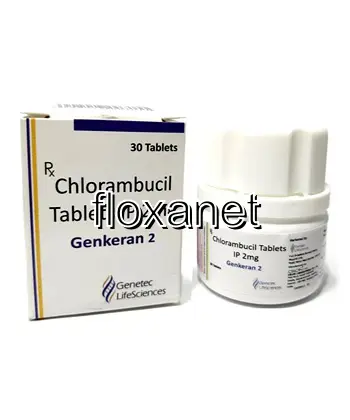| Package | Dosage | Price | Price per Dose | |
|---|---|---|---|---|
| Dosage: 2mg | ||||
| 90 pill | 2mg | AUD1,462.27 | AUD16.24 | |
| 60 pill | 2mg | AUD1,071.48 | AUD17.86 | |
| 30 pill | 2mg | AUD575.65 | AUD19.18 | |
| Dosage: 5mg | ||||
| 90 pill | 5mg | AUD2,058.95 | AUD22.88 | |
| 60 pill | 5mg | AUD1,508.49 | AUD25.15 | |
| 30 pill | 5mg | AUD831.97 | AUD27.73 | |

Chlorambucil Description
Overview of Chlorambucil
Chlorambucil is a chemotherapy medication primarily used in the treatment of various forms of cancer. It belongs to the class of drugs known as alkylating agents, which work by interfering with the DNA in cancer cells. This interference prevents the cells from multiplying and growing, ultimately leading to their death. Chlorambucil is often prescribed for conditions like chronic lymphocytic leukemia, Hodgkin's lymphoma, and certain other lymphomas. Its oral formulation makes it convenient for patients to take at home, but careful adherence to dosage schedules is essential to maximize effectiveness and minimize side effects.
Mechanism of Action
The drug works by alkylating the DNA in malignant cells. When Chlorambucil is metabolized in the body, it forms active compounds that attach to the DNA strands. This attachment causes cross-links between DNA strands, inhibiting DNA replication and transcription processes. As cancer cells rely heavily on rapid DNA synthesis, they are more vulnerable to these effects, leading to cell death. Unlike some other chemotherapeutic agents, Chlorambucil tends to have a long half-life, which allows for less frequent dosing schedules while maintaining its therapeutic effects.
Benefits and Therapeutic Uses
Chlorambucil is valued for its effectiveness in managing certain blood cancers. Its oral administration route enhances patient convenience, reducing the need for frequent hospital visits. Patients with chronic lymphocytic leukemia often benefit from this medication, especially in early stages or when other treatments are unsuitable. Additionally, it can be used as part of combination therapy to improve outcomes for lymphoma patients. The drug can also be useful in palliation, helping to alleviate symptoms associated with advanced disease. Despite its benefits, the decision to use Chlorambucil depends on careful assessment by a healthcare professional, considering potential risks and expected benefits.
Possible Side Effects and Precautions
Like all chemotherapy drugs, Chlorambucil can cause side effects. Common adverse reactions include nausea, vomiting, and loss of appetite. It can suppress bone marrow activity, leading to lowered blood cell counts, which increases the risk of infection, anemia, and bleeding. Patients might experience tiredness, hair loss, or mouth sores during treatment. Long-term use may increase the risk of secondary malignancies such as skin cancers. Before starting therapy, patients should inform doctors about their full medical history, including any liver or kidney issues. Regular blood tests are necessary during treatment to monitor for potential complications. Patients are advised to adhere strictly to dosing schedules and report any unusual symptoms to their healthcare provider promptly.
Conclusion
Chlorambucil remains a relevant option in the arsenal against certain hematologic cancers. Its ability to be administered orally makes it a convenient choice for many patients. However, due to its significant potential for side effects, careful medical supervision is required. Proper patient selection, dosing, and monitoring can help optimize outcomes while minimizing risks. If prescribed, it is crucial to follow medical advice closely to ensure safety and effectiveness throughout the treatment course.
